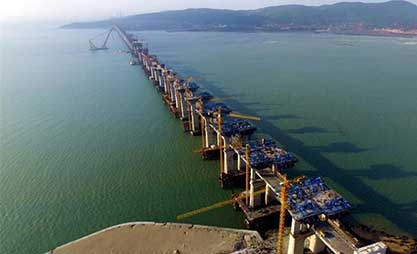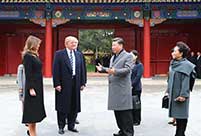

Modern Agriculture
In 2016, Guangzhou strongly advocated the structural reform of the supply side at the agricultural sector, strengthening agricultural development, bringing prosperity to farmers and beautifying the countryside, thus achieving remarkable results through pushing the economic and social development of the rural areas. The city reaped the total output of 43.769 billion yuan in the agriculture, forestry, animal husbandry and fishery sector, with the added value of 26.030 billion yuan. The per capita disposable income of the rural permanent residents reached 21,139 yuan in the meanwhile.
Modern Industry
In 2016, Guangzhou led the nation in the fields of industry and information economy concerning such key indexes as overall size, comprehensive strength, quality and efficiency. The enterprises above the designated scale registered the total output of 1,955.625 billion yuan and the added value of 487.785 billion yuan, both up 6.5% year on year. The growth rate of the added value of the enterprises above the designated scale was 0.5 percentage points higher than the average level of the nation.
Information Economy
In 2016, Guangzhou’s information economy played a prominent part in leading the local economy and the city was ranked as No.3 of the Top Ten “Internet Plus” Model Cities of the nation, surpassing Shanghai. Meanwhile, 8 local enterprises were selected to the 2016 “Top 100 Chinese Internet Enterprises” list, with the total number ranking on the top in China. The city realized the software and information service revenue of 260 billion yuan throughout the year, up 15% year on year. The city was also ranked as No.2 of all Chinese cities for urban informationization and top three on the “Internet Plus” cities list.
Modern Service Industry
The dominant role of the city’s service economy, which was transforming to the high-end model more quickly and significantly, was further strengthened in 2016. Guangzhou reaped the total service industry added value of 1,344.503 billion yuan, up 9.4% year on year, while the ratio of the modern service industry in the third industry was up 0.9 percentage points, reaching 65% in the mean time.
In 2016, the city’s social retail goods totaled 870.649 billion yuan while the wholesale and retail sales stood at 5,597.275 billion yuan and the commodity import and export was 856.692 billion yuan. The ratio of the third industry in the local GDP also reached 68.6% in the meantime.
Financial Institutions: In 2016, the city was home to 281 financial institutions of all kinds, including 84 banks, 23 non-bank financial institutions, 79 securities, futures and fund institutions and 95 insurance companies. There were 212 domestic financial institutions and 69 foreign financial institutions.
In addition, there were also 93 micro-credit companies, 1 micro re-loan company, 7 village/town banks, 42 financing guarantee institutions, 6 domestic and foreign currency exchange franchises as well as 1,700 business-starting and equity investment institutions.
Financial Income: In 2016, the amount of deposits in home and foreign currencies in Guangzhou’s financial institutions stood at 4.75 trillion yuan, with the amount of outstanding loans of 2.97 trillion yuan, ranking as No.4 of all Chinese big cities. In the same year, the securities sector finished the transactions of 14.18 trillion yuan and the futures market reaped in 3.84 trillion yuan while the total premium income reached 116.6 billion yuan, firmly remaining No.3 of all Chinese big cities.
In the same year, the added value of the city’s financial sector totaled 180.042 billion yuan, surpassing real estate as the No.5 pillar industry of the city as far as output is concerned, ranking as No.4 of all Chinese big cities and becoming a major driver for the city’s economic growth.
Real Estate
In 2016, the real estate sector finished the investment of 254.085 billion yuan, up 18.9% year on year. The construction of a total of 21, 323,800 square meters of new housing had been launched, up 22.5% year on year. The total annual first-hand housing transaction of the city reached 141.6 million square meters, up 31% year on year, with the average price of 16,600 yuan per square meter, up 10.2% year on year.
Capital Market: In 2016, the city boasted 133 local companies being listed at home and abroad and Guangzhou Equity Exchange had 5,646 listed companies. Local companies listed at home had the total market value of 2.15 trillion yuan.
Postal Services. In 2016, the city’s postal service sector reaped the total business throughput of 61.133 billion yuan with the business income of 30.702 billion yuan, up 53.70% and 38.12% year on year, respectively. The amount of express mails throughout the year reached 2.867 billion pieces with the business income of 27.546 billion yuan, up 46.87% and 40.55% year on year, respectively. The average daily amount of express mails reached 7.29 million pieces, ranking as No.1 of all domestic cities.
Tourism: In 2016, Guangzhou accommodated 185 million person-times of tourists, up 6.93% year on year, and reaped 321.705 billion yuan in the total revenue, up 12.01% year on year, including 6.272 billion US dollars of foreign exchange, up 10.11% year on year, and 280.058 billion yuan of domestic tourism income, up 12.67% year on year. The growth rate of the tourism sector’s total revenue has kept growing faster than the growth rate of GDP during the same period of time for many years.
In the same year, the city had a total of 50 A-class tourism zones, 525 travel agencies, 187 star hotels, 32,796 tour guides and 4,500 tour leaders.
High & New Tech Industry
In 2016, the output of the city’s high and new tech products reached 899.588 billion yuan, taking up 46% of the total output of the enterprises above the designated scale. The output of the high and new tech products of the strategic new industries, which had been advocated specifically, all grew at a fast pace, including new generation information technology, biology and health, new material and high-end equipment, new energy car, new energy and energy conservation, fashion and innovation.
The city had established six national-class high tech industry bases including information, software, biology, new material, high-tech service industry and integrated high-tech industry, winning six national-class model city titles including National Model City for E-commerce. A total of six bases, including the new energy car base, were certified and granted the title of Guangdong Provincial Strategic New Industry Base.
 Chinese brand becomes largest handset provider in Africa
Chinese brand becomes largest handset provider in Africa Busty Lais Ribeiro steals the Victoria's Secret Fashion Show
Busty Lais Ribeiro steals the Victoria's Secret Fashion Show Highlights Victoria's Secret Fashion Show in Shanghai
Highlights Victoria's Secret Fashion Show in Shanghai China's first cross-sea rail-road bridge takes shape
China's first cross-sea rail-road bridge takes shape A fancy world painted on fallen leaves
A fancy world painted on fallen leaves Photo album: Xi-Trump meeting in Beijing
Photo album: Xi-Trump meeting in Beijing Pitaya flower: blooms for one night, yields delicious fruit
Pitaya flower: blooms for one night, yields delicious fruit Hol Xil: Ideal habitat for Tibetan animals
Hol Xil: Ideal habitat for Tibetan animals Skywalk made of glass opens in Guizhou's Yuntaishan
Skywalk made of glass opens in Guizhou's Yuntaishan Top 10 most sustainable cities in China
Top 10 most sustainable cities in China Top 10 European patent applicants in 2016
Top 10 European patent applicants in 2016 The power of 'She' in China
The power of 'She' in China Seven most beautiful art museums in China
Seven most beautiful art museums in China Cyber rumors must be effectively addressed
Cyber rumors must be effectively addressed
 Migrant workers leave Beijing in droves amid evictions enacted following deadly fire
Migrant workers leave Beijing in droves amid evictions enacted following deadly fire
 Profits before pupils
Profits before pupils
 Is Weibo still the best choice for young Chinese when it comes to social media platforms?
Is Weibo still the best choice for young Chinese when it comes to social media platforms?
Day|Week